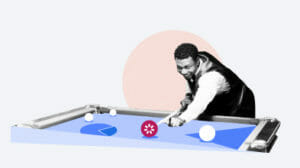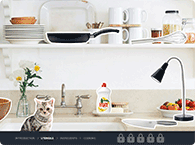How to Make a Jeopardy Game in PowerPoint

Many engaging interactive applications can be created in PowerPoint to gamify your eLearning experience. Playing a Jeopardy game is always a lot of fun. Moreover, every time you see those tiles with categories and different numbers, you can’t stop thinking of all the nostalgic moments in your life when you saw them on TV and were always wondering along with the contestants, “What’s the correct answer? Am I right or wrong?” It puts you in the participants’ shoes, even if you aren’t a guest on the show.
Now, with modern technology, you can create this game on your own in about 10-20 minutes from scratch and play it with your learners, colleagues, or friends! To learn how to make a Jeopardy game with clues that include pictures, audio, and video in Microsoft PowerPoint, watch the video tutorial below or skip to the article if you prefer reading. As a bonus, you’ll find a free Jeopardy template to experiment with at the end of the article.
Overview
To make a Jeopardy game, we’ll use the following features of PowerPoint:
- A table to create the game board (or a grid) hat shows categories and scores (or a cash value).
- Hyperlinks to connect each selection on the grid to its respective clue slide.
- Slide Master view to create unified slides that present clues and answers in a consistent style.
To publish the game in web format and share it online, we’ll use iSpring Suite, an authoring tool for creating eLearning content and converting PowerPoint presentations to an online format.
iSpring Suite
Fully-stocked eLearning authoring toolkit for PowerPoint. No training required to start!
How to Make a Jeopardy Game in PowerPoint in 5 Steps
We’ll use a PowerPoint table to create the Jeopardy game board. Then, we’ll add hyperlinks to each cell (e.g., SCIENCE for $400) that will link to the respective clue slide in the presentation. Finally, we’ll put our game into a web format.
If you’d like to create an interactive Jeopardy game on your own, follow this detailed guide.
Step 1. Create a game board
Step 2. Create clue and correct answer layouts
Step 3. Add all slides and link them to the grid
Step 4. Enhance your game with images, audio, and video
Step 5. Test and publish your game
Step 1. Create a game board
- Create a new PowerPoint presentation and name the first slide.
- Apply a theme to your presentation on the Design tab.
- Add a new slide and add a table by going to the Insert tab > Table.
- Create a table with 5 columns and 5 rows.

- Resize the table to match your slide and fill in the cells as shown in the picture below.

- Choose an appropriate color for your game board to get a more authentic look. You’ll find the paint bucket instrument called Shading in the Table Tools > Design tab.

After you complete all other steps, the game board will look like this, where each cell is a hyperlink to the respective clue:

Understanding Slide Layouts
Every PowerPoint slide has a Layout, such as Title Slide and Title and Content. You can select the specific layout when you right click on the slide’s thumbnail.

Also, you can edit and create new slide layouts in the Slide Master tool.
The layout-based approach and use of the Slide Master view are particularly important in the Jeopardy game, which has lots of similar slides of two types:
- Clue slide. Contains a clue text and an “Answer” button to check the correct answer.

- Correct Answer slide. Contains the answer to the respective clue and a “Home” button to return to the game board.

Changing the master slide’s content will automatically apply changes to every slide of that type in the presentation. For example, you can change the background, text placement, size, or font in Slide Master, then go back to the Normal view, and you’ll see that everything has been changed.
Step 2. Create Clues and Correct Answer Layouts
The layouts shown above are already included in the PowerPoint theme for the Jeopardy game. To see how they are made, To make them, follow these steps:
- Enter Slide Master on the View tab.
- Insert a new Layout.

- Rename it to “Clue.”

- Add a button to the slide. Go to the Insert tab and click Shapes > Action Buttons. Select a custom one and draw it on the slide.

- In the Action Settings window, set Hyperlink to: Next Slide.

- Right-click, select Edit Text, and add the caption “Answer” to the button.

- Similar to the clue slide, create a correct answer slide. Right-click on the left pane in the Slide Master view and select Insert Layout. Name it “Correct Answer”.
- Add a “Home” action button and point its hyperlink to Slide 2, which is the game board.

- Exit from the Slide Master view by clicking the button Close Master View on the top ribbon or select the Normal view in the View tab.
Step 3. Add all slides and link them to the grid
We already have the title slide and the game board slide. As well, we have the layouts for the Clue / Correct Answer pair.
- Add the third slide. Set Layout > Clue.
- Add the fourth slide. Set Layout > Correct Answer. It will look like this:

- You have the clue-answer pair now. Duplicate the 3rd and 4th slides as many times as there are active cells in the grid. In this example there are 20 clues, so the total number of slides will be 42, including the first two.
Note: We suggest you fill in the draft text for clues (e.g., Category 1 Question for $200). This will make it easier for you to find and link.
Link the grid cells to the respective slides throughout the entire presentation.
- Select the text in a cell, right-click, then select Hyperlink (or use the Ctrl+K shortcut).

- On the left pane, select Place in This Document and then select the respective slide (e.g., Category 1 Question for $200). Click Ok to insert the hyperlink.

Restrict navigation
Select all the slides except the first one and uncheck the On Mouse Click checkbox on the Transitions tab. This will establish fluid hyperlink/button navigation in your game, making it so that slides cannot be changed with mouse clicks.
Step 4. Enhance your game with images, audio, and video
You can enhance your game with audio and video, plus PowerPoint animations and slide transitions. You are free to add any effects you wish, to provide a more engaging gaming experience.
Also read: → How To Record PPT Presentations with Audio
Add pictures to your clues
Simply drag and drop any picture to the presentation, including PNGs with transparent background from your local disk. Otherwise, use the older method Insert > Pictures (or Online Pictures) to add an image that helps describe the clue (or serves to confuse contestants).

You can apply Effects like a shadow or wet floor from Picture Tools > Format. Add an animation if you like.
The correct answer is: Ribonucleic acid
Add music and make it play automatically (autoplay)
Drag and drop the audio file on the slide or go to Insert > Audio:

Go to Audio Tools > Playback and set Start: Automatically.

It’s recommended that you trim audio files to 15 seconds or so.
By the way, Musopen.org is a great online resource with music that can be downloaded and used legally and for free.
The correct answer is: Minor
Add video questions
Drag and drop the video on your clue slide or go Insert > Video.

Make it autoplay, similar to the audio, by going to Video Tools > Playback. Then set Start: Automatically.
Closed captioning may also help make this question available to everyone. Just add a text box with the CC text and place it underneath the video. The Appearance animation with a 9-second delay was used on this video question, so it doesn’t reveal the essence of the question before the words “exposed to these invisible rays” are spoken in the video.
The correct answer is: Ultraviolet rays
Other improvements
Here are a few tips on how to improve your game:
- Add transition effects for clue slides (Fade or Zoom) using Slide Master. Also, add the Flip transition to the slide with a correct answer, so it will look like you’re flipping a flash card.
- Add triggered animations to hide visited cells on the gameboard. You can see this in the sample PPTX file below. However, it doesn’t appear in the HTML5 web presentation.
- Add audio triggers (action buttons) to the clue slides such as sounds of applause or booing. You can activate any of these sounds during gameplay to make it more fun.
- If needed, add a second round and a final Jeopardy by adding a link on the game board slide that will lead to another part (you can insert the template again in the same presentation).
Step 5. Test and publish your game
Once your game is ready, make sure every link and other functionalities are all working correctly. Start your slideshow by clicking F5 (Slide Show > Start Slide Show) and experiment with it. Check your hyperlinks in the grid and make sure that they lead to correct clues.
If everything is working as intended, publish your original PowerPoint Jeopardy game in an online format. This will facilitate sharing it with your audience.
Here’s how you can do this with iSpring Suite:
- Go to the iSpring Suite page and download a free trial.
- Open your Jeopardy game presentation. You’ll see the new iSpring Suite tab in the PowerPoint ribbon. Go to this tab and click Publish.

- In the Publish Presentation window, select the My Computer tab and the HTML5 format, and then click Publish.

This is the best publishing option if you want to put your game on your website or blog. To upload it to your server, select FTP in the opened window.

If you want to export the game to your learning management system, choose the LMS tab in the Publish Presentation window.
If you don’t have a website or an LMS, select the iSpring Space tab on the menu at the left. iSpring Space is an online portal where you can store and share all your content.

Log in to your iSpring Space account and click Publish. Once the publishing process has finished, your account will open in a browser. You’ll see your uploaded game there. Just click on the title to run it.

If you’d like to share your Jeopardy presentation with other people, tap on your file → Share and open the public access. This way you’ll be able to deliver your game to everyone on the internet.

Just copy a link and send it to your friends, colleagues, or students. They’ll be able to open the Jeopardy game right in their browsers.
Play Your Game
Now comes the fun part! After you have created your own game, it’s time to invite other players! You’ll need two or more people in order to play the game, plus a piece of paper and pencil to write down the players’ score. Run the game either on your website or in iSpring Space and be the host. In the original TV version of this game, contestants can buzz in to give an answer. Because we are not in a studio, contestants can just clap to buzz in.
The rules are quite simple and easy to remember:
- The first player chooses the category and the points/complexity (e.g., Presidents of the United States for 30 points).
- The host clicks on the respective cell on the game board and reads the clue aloud (e.g., The Teddy Bear was invented in honor of this president after he refused to shoot a bear that was tied to a tree on a hunting trip.).
- After the host finishes reading the clue, any contestant can buzz in to give an answer (Who is Theodore Roosevelt?)
- If the correct answer was chosen, the player gets the points for this question and can select the next one.
- If the incorrect answer was chosen, the player receives a penalty, and the other contestants can buzz in.
- After all the questions on the game board have been answered, the player with the highest score wins.
To learn more about the official rules of Jeopardy, refer to this article on Wikipedia or search for other sources online.
Jeopardy can be played anywhere, from a kindergarten classroom to an office, with contestants of all ages. It’s a great way to train your employees on important business topics in an engaging manner and to introduce a little fun into a boring meeting or corporate presentation to lighten the tone. This game is not just about knowledge and swiftness, but also about breaking the ice and generating camaraderie.
Free Jeopardy Game Template
Don’t want to spend time creating the game from scratch? Then, just download our free PowerPoint template of the Jeopardy game and customize it as desired. Also, feel free to get a free trial of iSpring Suite to convert your game into an online format.
Other Games That Can Be Created in PowerPoint
PowerPoint is a fairly straightforward tool that almost anyone can use. However, as you’ve already discovered, if you know how to use hyperlinks to create trigger and animation tricks and set up navigation, you’ll be able to craft not only basic presentations but also other engaging games besides Jeopardy.
For example, you can create gamified training guides on how to perform a task, like this one about making a perfect omelet:
To find out how we made it, read this article on how to create a mini game in PowerPoint.
You can make even more engaging things by utilizing PowerPoint together with iSpring Suite. This software allows you to not only convert PPT presentations to web formats but also create great interactive content from scratch.
For example, you can build amazing quizzes with 14 question types, including hotspots, sequences, and drag-and-drops. Thanks to their interactivity and beautiful design, they are perceived by quiz takers not as typical tests but as engaging mini games. Just take a look at this quiz on merchandising:
With iSpring Suite, you can also create role-plays, which are interactive exercises that imitate a real conversation with a person: a customer, a staff member, or a colleague – and help people master communication skills. The key element of a role-play is its branching scenario, where each decision has consequences. A person chooses a certain option and gets a consistent outcome, as in a video game. Here’s an example of a role-play created with iSpring Suite:
If you want to build quizzes and role-plays on your own, download an iSpring Suite free trial and start making awesome content today.
Useful Resources on PowerPoint
Are you a PowerPoint lover? If so, here are some other helpful articles for you:




























